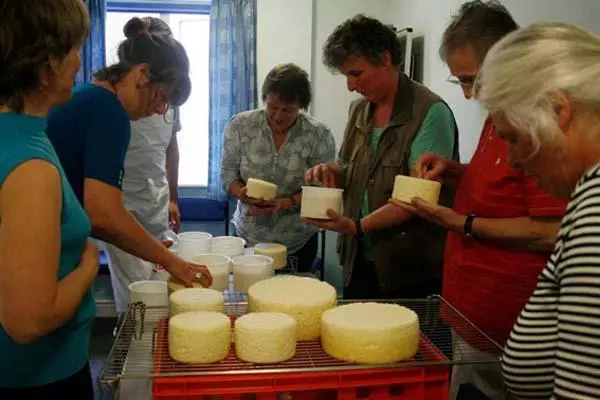Mobile Dairy School - Cheese production mobile unit
That CPMU is not ony a carrier of the diverse utensils needed for cheese making, but when compressed, its also a clasroom, a piece of furniture, a biotech lab, an stable and milking unit, a museum, a market stall , a temporary art room, and an (edible)-propaganda kiosk.
The project has three stages
1.- Cheese making workshops
2.- Cheese design and propaganda
3.- Building of Portable CPMU and extension of co-production social system.
The project takes as its starting point John Ruskin;s initiative of a Migratory Dairy School , as a project for Grizedale Arts, for local farmers, providing them with the necessary skills to diversify their outcome, increasing income from their produce.
Other influences include the Krausist Movement in Spain, that crystallized in 1876 in the Free Institution of Education (ILE).
During 2011 a CMPU 2 was also designed and built in Berlin to produce cheese and run workshop under the project Vorratskämmer with Myvillages, shown in Haus der Kulturen der Welte at the ULK show.
1.- Workshops and first test production
The Mobile Dairy School was intended to be not only geographically mobile but also socially mobile, being pitched at different sectors of society and cultural backgrounds. These workshops had diverse audience, from farmers to life-stylers and artists.
The utensils used for cheese making during the workshop came from the first prototypes designed and built for the Shepherds School, a project I started in 2005. Three tanks were set up, allowing the attendants to split in smaller groups and take an active role during the whole process of cheese making.
The milk (400 litres in total) came from the local dairy farm, Seizer Barn. The kind of cheese produced during the practical part of the workshop was mainly a self-pressed enzymatic hard cheese
The total cheese production was of around 38 kg. Ruskin´s former home, had offered Ruskin's Ice House for the cheese storage, for 3 months.
The first event was an evening of tasting the Workshops cheese, in Consiton Institute. Attendants encouraged to think up a name for the newly developed cheese.
The next event was a "philosophical cheese workshop", bringing together different cultural perspectives, from artists, historians, curators and art critics, to discuss ideas related to the cultural aspects around food production - the relevance of place and culture - and the relation that artists can build with their practice with it.
This conversation focussed on the ever changing attitudes towards food, community and tradition.
2.- Cheese design and propaganda
The cheese tasting was directed by the artist, and participants were provided with evaluation forms in which they scored the different aspects of each cheese, from shape to taste, aroma, flavour and texture.
All those forms, filled by each different social group gathered in each workshop, where compiled and processed with certain algorithmic software. The resulting data provide the average selection of the most desired traits of a cheese.
This information will be later translated by the artist which will lead to the final design of a cheese, tailored to the Cumbrian palette.
3.- Building of Portable CPMU and extension of co-production social system.
The third stage of the project involves making freely available the information on how to produce this new local cheese as well as providing access to the Cheese Production Mobile Unit, allowing dairy farmers in the area to experiment and maybe open new diversification possibilities in farm economy.
It will has a tank of 25 l. enough for a small production, at family farm scale. It combines stainless steel with a shell in molded plastic.
For this plastic material, it came the idea to use Galalith as milk-based plastic.
Galalith ( also known as Erinoid in UK) was one of the first synthetic materials, alongside bakelite and celluloid.
It was invented in 1889 by A. Spitteler and W. Kirsche from milk casein.
Therefore the device for milk transformation and cheese making is made itself from milk.
Once the CPMU is built, a group of roughly 6 local farmers and people interested in producing cheese at a small scale, are gathered to explain its use and organise the collective. There is the possibility to acquire as a group a small flock of goats of around 30 or 40 heads. This flock will not only produce some milk for cheese making but also help conserving pastures and open land.
A mobile electric fence is transported with the flock and the CMPU from farm to farm, to stay around 2 months in each farm, before going to the next. This collective system allows farmers to have free time from the demands of a milking flock. Grizedale Art will be part of this users and temporary nomadic cheesemakers community.
 Share / Save
Share / Save








Commenti 0
Inserisci commento